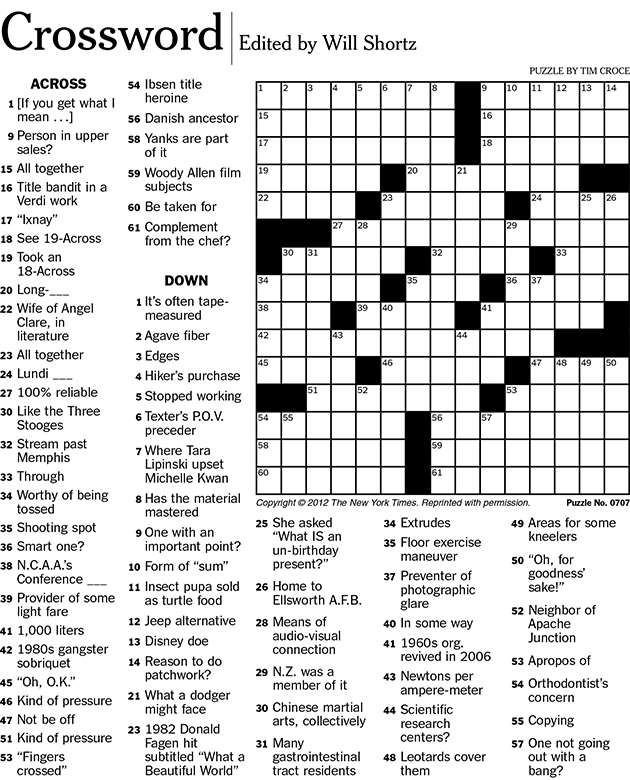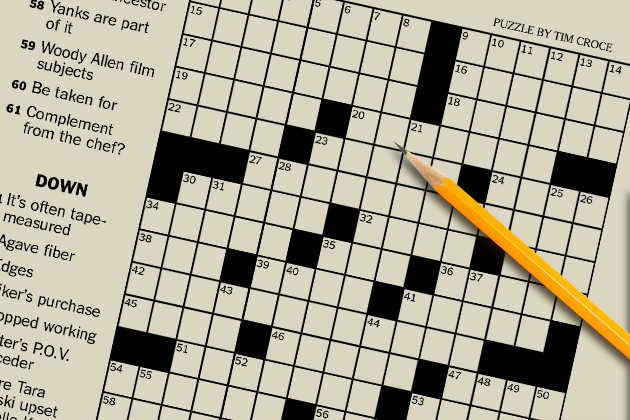ACROSS
1. Met his wife while both performed in the Pride of Connecticut.
DOWN
1. The pre-eminent publisher of the cleverest, most engaging, and at times trickiest crossword puzzles.
Intrigued? You may be a cruciverbalist, one of three words Tim Croce ’05 (ENG) (answer to 1/Across) uses to describe himself. Croce has created more than 25 crossword puzzles for The New York Times (answer to 1/Down).

Creative and competitive are two other adjectives that aptly describe Croce’s personality. Just try matching wits with him by attempting to solve the puzzle accompanying this story, recently published in The Times and reproduced with permission.
“Unfortunately, it’s a Saturday puzzle,” says Will Shortz, New York Times puzzle editor, “which is one of Tim’s specialties. This means it’s really, really hard. Only the most expert solvers can probably do it!”
The Times’ daily crossword puzzles grow increasingly difficult from Monday to Saturday, and each earns its creator $200; Sunday’s puzzle is so complex the newspaper pays its creator $1,000.
To date, Croce’s puzzles have been published on Wednesday, Thursday, Friday, and Saturday; as this story goes online, several of his puzzles are slated for Tuesday publication and another is scheduled for a Monday. “My goal is to hit for the cycle, having a puzzle published in The New York Times on every day of the week,” he says.
Now 29, Croce’s interest in crossword puzzles began when he solved kiddy-style puzzles for kindergarten assignments; by age 9 or 10, he was doing newspaper-style crosswords. “Mom used to do a lot of puzzles, so I’d solve crosswords with her,” he says. “Three out of my four grandparents also did crosswords and we’d solve them together. I guess crosswords are in my blood.”
In a nod to how much crossword puzzles have become part of his identity, Croce’s Twitter avatar is an ostrich. Oops, erase that. “It’s an emu,” Croce says. “It’s a word you find pretty often in crosswords because, of its three letters, two are vowels.”
Emu is also a word that crossword puzzle enthusiasts (cruciverbalists) consider clean, meaning it’s not a word that’s used only in crosswords. “The New York Times publishes fewer than 10 percent of the puzzles that are submitted for consideration,” Croce says. “Will [Shortz] looks for puzzles that use clean words, and answers with unusual letter combinations.”
For The Times’ theme-free Friday and Saturday puzzles, Croce says, “I’ll just hear a current, fresh word or a phrase on the news, so I’ll put it at 1 Across. If it’s an interesting fact, I might use Google or Wikipedia to come up with the clue. If I’m stuck for an original clue, I’ll look in the dictionary for something in one of the definitions that I can twist in a creative way not used before. I don’t have a library of hard-bound reference books. I have a lot of bookmarked websites.”

Croce has a computer program that lists every puzzle clue published in The Times and The LA Times for the past several years. “If it’s a new word and the same clue has been used twice, there’s no way I’m repeating that clue,” he says. “I want as much of my puzzles to be original as possible. But for common words that have been used several hundred times, I don’t have a problem repeating the clue.”
He constructs the puzzles using a crossword compiler program, using it to lay out each puzzle’s grid; the software also provides a database of incomplete words. If he’s filled in “_ E R _ _ S” he enters “?ER??S” and the compiler reveals letters that complete the blanks with real words. The software description makes creating crossword puzzles sound like a snap, but on closer investigation the software seems as complicated as completing a long-form tax return. And the human creator still has to know foreign words, proper nouns, and phrases.
“Making crossword puzzles is an art, but at its heart it’s putting stuff together, thinking logically,” Croce says. “At its essence it’s a very structural process, building one thing on top of another, with a scientific mind. You’ve got to think as if you were a computer sometimes.”
An environmental engineer for the City of Pittsfield, Mass., Croce attended UConn in Storrs for his four years of undergraduate studies, during which time he met his wife. He’s a member of UConn’s 2011 Honor Roll of Donors, and says he gives because, “UConn fueled my competitive fire. You couldn’t just get by in the competitive UConn School of Engineering – you had to have a competitive spirit that made you stick out and not get lost. The rigor of the program didn’t let you graduate without knowing that you could thrive in a competitive environment.”
He was with the pep band in New Orleans in 2004 when the UConn women won the NCAA basketball championship, right on the heels of the men’s victory. “In my UConn years, I saw a lot of winning first hand. It was surreal,” Croce says. “That was a super good year for me in sports. It was the first time UConn’s football team went to a bowl game, and the Red Sox won, and the Patriots won in football. All five of the teams I follow most fervently achieved the high water mark.”
Usually, big successes are preceded by smaller victories. For example, even a cursory investigation of how to break into crossword puzzle sales turns up advice that novice puzzle makers start with smaller publications and work up to the paper of record. Not Croce’s style.
“I was unwilling to sell my puzzles anywhere but The Times,” he says. “I felt that if my puzzle wasn’t good enough for The Times, then I’m not sending it anywhere else.” That’s meant he has had a few rejections – of the 70 to 80 puzzles he’s created, about 50 are unsold. But it’s not making the sale that drives him.
“It’s creating a complete puzzle that I find fascinating,” Croce says. Each puzzle usually takes him a few days to a week to complete, working at it for about an hour at a time, although a few puzzles have come together in a day or two.
“I’ve been sitting on some puzzles for months, even years,” he says. “I’ll come back to one of those puzzles and have a spark. You ask yourself, ‘How come I didn’t see that before?’ If I keep staring, I keep thinking the same way. Taking a break gives me a new perspective.”




